 |
PO Box 9021,
Wilmington, DE 19809, USA
E-mail: font@focusonnature.com
Phone: Toll-free in USA 1-888-721-3555
or 302/529-1876 |
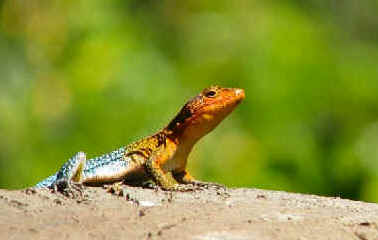 Amphibians
Amphibians
and Reptiles
of CHILE and
ARGENTINA
Noting those found during
Focus On Nature Tours
with an (*)
including:
Toads & Frogs
(seen & heard) Turtles
Lizards & Geckos
Snakes
A list of Amphibians and
Reptiles in Chile and Argentina
compiled by Armas Hill
UPPER RIGHT PHOTO: a THIN THREE LIZARD, a Chilean endemic,
photographed during the FONT Tour in Chile in November 2011.
Two others photos of this species are in the list below.
(photo by Frank Stermitz)
Codes:
AR:
occurs in Argentina
CH: occurs in Chile
(CHi): introduced in Chile
(CHvr): very rare in Chile (often considered endangered or
threatened in the country)
(CHr): rare in Chile
(CHv): considered vulnerable in Chile
An excellent book with information and color illustrations of the Chilean
species in this list is ""A Wildlife Guide to Chile"" by
Sharon Chester, published in 2008.
Numbers noted as (WGC:xxx) refer to pages with an
illustration of the species in "A Wildlife Guide to Chile".
(ph): species with a photo in the FONT website
Links:
Upcoming FONT Birding & Nature Tours in Chile & Argentina
A List & Photo Gallery of Chile Birds, in 2 parts:
Part #1: Quails to Becard Part #2: Flycatchers to Buntings
Mammals
in Chile (with some photos)
Butterflies in Chile
(with some photos)
Directory of Photos in this Website

List:
AMPHIBIANS:
Toads & Frogs:
Family BUFONIDAE: True Toads
- Concepcion Toad (CHv) ______ CH
(WGC:121)
CH common name: Arunco
Chaunus (or
Bufo) arunco (or chilensis)
Endemic to Chile, Chaunus arunco occurs in dry steppe habitat
from Coquimbo to Concepcion, where it is found from the seacoast into the
mountains up to almost 5,000 feet.
Chaunus arunco, a land toad often away from water, is the largest
terrestrial amphibian in Chile. It streams in large numbers during its
breeding season to brooks in central Chile.
- Atacama
(or Vallenar) Toad (CHv) ______ CH
(WGC:121)
CH common name: Sapo del Desierto
Chaunus
(or Bufo) atacamensis
Endemic to Chile, Chaunus atacamensis occurs in coastal Atacama.
- Red-spotted Toad (CHv) ______ AR
CH (WGC:121)
CH common name: Sapo
Chaunus
(or Bufo) rubropunctatus
In Chile, Chaunus rubropunctatus occurs from Biobio to Los
Lagos. It is also in nearby Argentina. Its habitat is wet to dry Nothofagus
forest.
- Warty Toad (CHv) ______ AR
CH (WGC:121)
AR common name: Sapo Espinoso
CH common name: Sapo Espinosus
Chaunus
(or Bufo) spinulosus
Chaunus spinulosus papillosus (a subspecies in Argentine
Patagonia)
In Argentina, Chaunus spinulosus lives in Andean streams in the
northern half of the country. It hides beneath stones and in
burrows.
In Chile, Chaunus spinulosus occurs from Arica to Valparaiso.
- Argentine Common Toad ______ AR
AR common name: Sapo Comun
Chaunus
(or Bufo) arenarum
In Argentina, Chaunus arenarum is to be found
"everywhere" in the northern part of the country, east of the
Andes. It reproduces in lakes and marshes.
- Patagonian Toad ______ AR
CH (WGC:121)
Chaunus
(or Bufo) variegatus
In Chile, Chaunus variegatus is fairly rare, occurring from Laguna del Laja in Biobio to
Isla Wellington in Magallanes. It is also in southern Argentina.
The species lives in cold, wet forest, in bogs, and on the Magellanic
tundra. Often it is found under logs in southern Nothofagus forests. It
breeds in shallow temporary pools and swamps.
- Cururu Toad ______
AR
AR common name: Sapo Cururu
Chaunus
(or Bufo) paracnemis
In Argentina, Chaunus paracnemis in the northern (&
northeastern) part of the country in open areas It breeds in pools and
lakes, and prefers to song in the water.
- Yellow Cururu Toad ______ AR
AR common name: Sapo Cururu Amarillo
Chaunus
(or
Bufo)
ictericus
In Argentina, Chaunus ictericus occurs in Misiones in forest streams.
- Common Lesser Toad ______ AR
AR common name: Sapito Comun
Chaunus
(or
Bufo)
granulosus fernandezae
In Argentina, Chaunus granulosus occurs in the northeastern part
of the country south to Buenos Aires. It hides in small burrows dug by the
frogs themselves. They breed in lakes, ditches, and pools of rainwater.
- Striped Toad ______ AR
AR common name: Sapo Franjeado
Chaunus (or Bufo) crucifer
In Argentina, Chaunus crucifer occurs in Misiones.
Family BATRACHOPHRYNIDAE: Helmeted Water Toads
Helmeted Water Toads
are the largest Chilean amphibians. Tadpoles are about 6 inches long before
losing their tails. Adult males are about 5 inches in length, and adult
females are normally twice that size.
- Helmeted Water Toad
(or Chilean Toad) (CHv) ______ CH
(WGC:121)
CH common name: Rana Chilena Gigante
Caudiverbera caudiverbera
Endemic to Chile, Caudiverbera caudiverbera occurs from Coquimbo to Los
Lagos.
- Chile Mountains False
Toad (CHr)
______ CH (WGC:121)
CH name: Sapo Hermoso
Telmatobufo venustus
Telmatobufo venustus
is so rare that in 1999 it was found in the Andean forest of
Maule and Biobio for the first time in over 100 years. The species is
endemic to Chile.
- Telmatobufo
australis (CHr) ______
AR CH
Telmatobufo australis
occurs in southern Chile & Argentina.
- Telmatobufo
bullocki (CHr) ______ AR CH
Telmatobufo bullocki
occurs in southern Chile & Argentina.
Family LEIUPERIDAE: Four-eyed Frogs
Four-eyed Frogs
are named for the bump on their hips, which gives the impression that
they have an extra set of eyes.
- Chile Four-eyed Frog
______ AR CH
(WGC:121)
CH common name: Sapito de Cuatro Ojos
Pleurodema thaul
In Chile, Pleurodema thaui occurs from Atacama to Los Lagos. It
is also in Argentina.
In Chile, it is abundant in sclerophyll and Nothofagus forests, but it is
also found in grasslands, urban areas, and other altered habitats.
- Marbled Four-eyed Frog ______ CH
Pleurodema marmoratum
Pleurodema marmoratum is
locally common in the puna and altiplano above 12,750 feet in Chile,
Bolivia, and Peru.
- Gray Four-eyed Frog ______ AR
CH (WGC:121)
Pleurodema bufoninum
Pleurodema bufonimum occurs in steppe habitat in Chile
from Biobio to the Strait of Magellan, and also in nearby Argentine
Patagonia.
- Rufous Four-eyed Frog ______ AR
AR common name: Rana de Cuatro Ojos Rojiza
Pleurodema borelli
In Argentina, Pleurodema borelli occurs in the central
portion of the northern part of the country, in the high altitude puna.
- Achala's Four-eyed Frog ______ AR
AR common name: Rana de
Cuatro Ojos de Achala
Pleurodema kriegi
In Argentina, Pleurodema kriegi is
endemic to the Cordoba hills.
- Guayapa's Four-eyed Frog ______
AR
AR common name:
Escuercito Chico Guayapeno
Pleurodema guayapae
In Argentina, Pleurodema guayapae
occurs in the central portion of the northern part of the country, where it
is found in salt lakes and salt pans. It lives underground, only coming out
when it rains.
Family CERATOPHRYIDAE:
Wood Frogs
- Marbled Wood Frog ______ AR
CH
(WGC:123)
CH common name: Sapo
Batrachyla
antartandica
Batrachyla antartandica
occurs in Chile from Valdivia to Los Lagos and in southern Argentina, where
it is found in wet temperate to cold Nothofagus forests in bogs, wetlands in
the forest, shorelines of ponds, marsh-fringed lakes, and irrigated farms
and gardens.
- Gray Wood Frog (*) ______ AR
CH
(WGC:123)
CH common name: Sapo
Batrachyla leptopus
In Chile, Batrachyla leptopus
occurs from Biobio to Los Lagos, and possibly to the Strait of Magellan. It
is also in southern Argentina. Its habitat is temperate Nothofagus
forest.
- Nibaldo's Wood Frog ______
CH (WGC:123)
Batrachyla nibaldoi
Endemic to Chile, Batrachyla nibaldoi occurs
in temperate rainforest on the eastern slope of the Andes in Los Lagos and
at a couple locations in Aisen.
- Banded Wood Frog (CHv) ______ AR
CH (WGC:123)
CH common name: Sapo
Batrachyla taeniata
Batrachyla taeniata occurs
in Chile from Coquimbo to Los Lagos, and Neuquen to the lower Rio Negro in
Argentina. It is found in a wide variety of habitats.
Family CERATOPHRYIDAE
Subfamily TELMATOBINAE: Water Frogs
- Marbled Water Frog ______ AR
CH (WGC:123)
Telmatobius marmoratus
Telmatobius marmoratus occurs in the High Andes of northern Chile,
southern Peru, Bolivia, and northwest Argentina.
- Zapahuira Water Frog (CHr) ______ CH
Telmatobius
zapahuirensis
Endemic to Chile, Telmatobius
zapahuirensis occurs in streams and small rivers in the High Andes.
- Telmatobius
vilamensis ______ CH
In Chile, Telmatobius vilamensis (above) and
Telmatobius petauri (below) are both fairly common in montane
rivers locally in the High Andes, in the areas of the Rio Vilama and the El
Tatio Geyser, near San Pedro de Atacama.
Telamatobius vilamensis is endemic to Chile.
- Arico Water
Frog (CHr) ______ CH
Telmatobius
pefauri
Telamatobius pefauri is endemic to Chile.
- Puquios Water Frog
______ CH
Telamatobius
fronteriensis
Telamatobius fronteriensis
occurs locally in Chile, having been found in streams near the town of
Ollague in Antofagasta.
- Telamatobius dankoi
______ CH
Telamatobius dankoi is endemic to Chile.
- Hall's Water Frog (CHr) ______ CH
Telamatobius halli
Telamatobius halli is endemic to Chile.
- Philippi's Water Frog ______ CH
Telamatobius philippii
Telamatobius philippii is endemic to Chile.
Family CYCLORAMPHIDAE
Subfamily ALSODINAE: Ground Frogs
- Chiloe Island Ground Frog ______ AR
CH
(WGC:123)
Eupsophus calcaratus
Eupsophus calcaratus
occurs in Chile from Biobio to Aisen, and in adjacent Argentina. It
lives near rivers and in wet forests.
- Nahuelbuta Ground Frog ______ CH
(WGC:123)
Eupsophus
nahuelbutensis
Endemic to Chile, Eupsophus
nahuelbutensis is fairly common in the Nahuelbuta Range from nearly
3,000 feet to nearly 5,000 feet above sea level.
- Rosy Ground Frog ______ AR
CH (WGC:123)
Eupsophus roseus
In Chile, Eupsophus roseus is locally common from Maule to the
Chhonos Archipelago and Aisen.
In Argentina, it occurs in the Rio Negro region.
- Valdivia Ground Frog ______
CH (WGC:123)
Eupsophus vertebralis
In Chile, Eupsophus
vertebralis occurs from Biobio to Chiloe.
- Contulmo Ground Frog ______ CH
Eupsophus contulmoensis
Endemic to Chile, Eupsophus contulmoensis
is known only in Contulmo in the Malleco province, Chile. It lives
under logs and rocks in Nothofagus forest.
- Mocha Island Ground Frog (CHr) ______
CH
Eupsophus insularis
Endemic to Chile, Eupsophus insularis is
found on Mocha Island, off the central Chilean coast, where it lives under
logs in mixed temperate forest.
- Emilio's Ground Frog ______ AR
CH
Eupsophus emiliopugini
Eupsophus emiliopugini has
been found only in Chile in La Picada in Osorno province, and on Isla Kent
also in the southern part of the country, and in Argentina in the Lago Puelo
National Park.
- Miguel's Ground Frog (CHr) ______ CH
Eupsophus migueli
Eupsophus migueli is endemic to Chile.
Family CYCLORAMPHIDAE
Subfamily ALSODINAE: Emerald Forest
Frogs
These are beautiful
frogs that live in humid forests from Valdivia to the Chonos Archipelago in
Chile, and in adjacent Argentina.
- Emerald Forest Frog ______ AR
CH (WGC:123)
Hylorina sylvatica
Hylorina sylvatica has
been found locally in southern Chile and adjacent Argentina.
In Chile, it has been found in forested areas from the Cordillera de
Nahuebuta to Laguna San Rafael.
In south-central Argentina, it has been found in the Los Alerces National
Park.
Family CYCLORAMPHIDAE
Subfamily ALSODINAE: Spiny-chest Frogs
- Black Spiny-chest Frog (CHr) ______
AR CH (WGC:123)
CH common name: Sapo Arriero
Alsodes nodosus
Endemic to Chile, Alsodes nodosus occurs from
Valparaiso to Maule. It lives in forest
and ravines with ample vegetation and freshwater.
- Cabreria Spiny-chest Frog (CHr) ______
CH (WGC:123)
Alsodes barrioi
Alsodes barrioi is found
in Chile in the Nahuelbuta Range, where it lives under logs and rocks near
mountain streams in Nothofagus dombeyi and Araucaria forest.
- Vanzolini's Spiny-chest
Frog (CHv) ______ CH
Alsodes vanzolini
Endemic to Chile, Alsodes vanzolini inhabits small patches of coastal
Nothofagus forest in the southern part of the country.
- Alsodes verrucosus
______ CH
Alsodes verrucosus (above)
and Alsodes australis (below) are known from Aisen and
Magallanes in southern Chile.
- Alsodes australis
______ CH
- Hugo's Spiny-chest
Frog ______ CH
Alsodes hugoi
Alsodes hugoi is endemic to Chile.
- Kawesshkar's Spiny-chest
Frog ______ CH
Alsodes kaweshkari
Alsodes kaweshkari is endemic to Chile.
- Potrero Spiny-chest
Frog ______ CH
Alsodes laevis
Alsodes laevis is endemic to Chile.
- La Parva Spiny-chest
Frog (CHr) ______ CH
Alsodes tumultuosus
Alsodes tumultuosus is endemic to Chile.
- Valdivia Spiny-chest
Frog ______ CH
Alsodes valdiviensis
Alsodes valdiviensis is endemic to Chile.
- Malleco Spiny-chest
Frog ______ CH
Alsodes vittatus
Alsodes vittatus is endemic to Chile.
- Tolhuaca Spiny-chest
Frog ______ CH
Alsodes igneus
Endemic to Chile, Alsodes
igneus was described in 2005.
- Mountain Spiny-chest
Frog (CHr) ______ CH
Alsodes montanus
Endemic to Chile, Alsodes montanus was first described back in 1902.
- Island Spiny-chest Frog ______ CH
Alsodes monticola
Endemic to Chile, Alsodes monticola was first described back in 1843.
- Oncol Spiny-chest Frog ______ CH
Alsodes norae
Endemic to Chile, Alsodes norae was recently described in 2008.
Family CYCLORAMPHIDAE
Subfamily CYCLORAMPHINAE: Mouth-brooding Frogs
- Darwin's Frog (CHv)
______ AR CH (WGC:123)
CH common names: Sapito Vaquero, Narigon
Rhinoderma darwinii
In southern Chile, from Biobio to
Aisen, Rhinoderma darwinii occurs on western slopes of the Andes, the
Central Valley, and the Coastal Range. It also occurs in adjacent Argentina.
Populations are declining for reasons that may be unknown, but some possible
causes are habitat destruction, pollution, climate change, or
disease.
Darwin's Frogs have many different color patterns, but can always be
identified by their long pointed snout.
- Rhinoderma rufum (CHvr)
______ CH
Rhinoderma rufum was last seen in
Chile (where endemic) in 1978 and is possibly extinct. This, and Rhinoderma darwinii,
are the only two members of the Family Cycloramphidae.
REPTILES:
Turtles:
Family CHELONIIDAE
Subfamily CHELONIINAE
- Green Turtle (t) ______ CH
(WGC:107)
CH common name: Tortuga Verde
Chelonia mydas
Chelonia mydas
occurs in Chilean oceanic waters from Arica to Chiloe, and occasionally
further south.
During the austral summer, the species feeds in the warm waters off the
mouth of the Rio Loa, between Iquique and Antofagasta.
Subfamily CARETTINAE
- Loggerhead Turtle (t) (ph) ______ CH
(WGC:107)
CH common name: Tortuga Boba
Caretta caretta
Caretta caretta
occurs uncommonly to rarely in oceanic waters off the coast of Chile,
from Arica to Coquimbo.
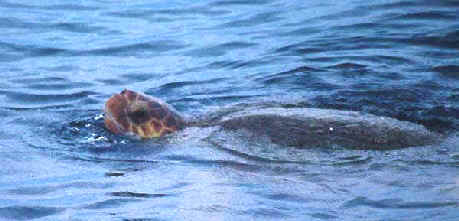
Loggerhead Turtle
(photo by D. Roberson)
- Olive Ridley Turtle ______ CH
(WGC: 107)
CH common name: Tortuga Verde
Lepidochelys olivacea
Lepidochelys olivacea
occurs rarely in oceanic waters off the coast of Chile between
Valparaiso and San Antonio.
Family DERMOCHELYIDAE
- Leatherback Sea Turtle (t) ______
CH (WGC:107)
CH common name: Tortuga Laud
Dermochelys coriacea
In Chilean offshore waters, Dermochelys coriacea has uncommonly
been caught by fisherman out of central part of the country.
Lizards and Geckos
Family IGUANAIDAE: Iguanid Lizards
Subfamily TROPIDURINAE: Neotropical Ground Lizards
- Brilliant Lizard ______ CH
(WGC:111)
CH common name: Lagartija Rayada Nortina
Liolaemus alticolor
In Chile, Liolamus altcolor occurs from Arica to Tarapaca, in
tola scrub on the Altiplano, to 13,000 feet above sea level.
- Liolaemus atacamensis ______
CH
Liolaemus atacamensis
is endemic to Chile.
- Barbara's Lizard ______ CH
Liolaemus barbarae
Endemic to Chile, Liolaemus barbarae was described in 2002.
- Dusky Lizard ______ CH
(WGC:111)
CH common name: Lagartija Parda
Liolaemus bellii (altissimus)
In Chile, Liolaemus belli occurs at Volcan el Morado and in the
Andes near Santiago
- Andean Lizard ______ CH
(WGC:110)
CH common name: Lagartija Andina
Liolaemus andinus (molinai)
Endemic to Chile, Liolaemus andinus occurs in Antofagasta.
- Liolaemus audituvelatus
______ CH
Liolaemus audituvelatus
is endemic to Chile.
- Liolaemus bisignatus ______
CH
Liolaemus bisignatus
is endemic to Chile.
- Buerger's Lizard ______ CH
(WGC:110)
CH common name: Lagartija de Buerger
Liolaemus buergeri
In Chile, Liolaemus buergeri occurs from Maule to
Biobio.
- Chilean Lizard (CHv) ______ CH
(WGC:110)
CH common name: Lagartija Chilena
Liolaemus chiliensis
In Chile, Liolaemus chiliensis occurs from Coquimbo to Los Lagos.
- Liolaemus confusus ______
CH
Endemic to Chile, Lioaemus confusus was described in 2006.
- Cyan Lizard ______ AR
CH (WGC:110)
CH common name: Lagartija de Vientre Azul
Liolaemus cyanogaster
In Chile, Liolaemus cyanogaster occurs in a variety of habitats
from Concepcion to Chiloe. It is also in adjacent Argentina.
- Liolaemus enigmaticus
______ CH
Endemic to Chile, Liolaemus enigmaticus was described in 2005.
- Fabian's (or Yanez's) Lizard ______ CH
(WGC:110)
CH common name: Lagartija de Fabian
Liolaemus fabiani
Endemic to Chile, Liolaemus fabiani occurs at Salar de Atacama, on salt
flats.
- Liolaemus filiorum ______
CH
Endemic to Chile, Liolaemus filiorum was described in 2005.
- Fitzinger's Lizard
______ CH
(WGC:110)
CH common name: Lagartija de Fitzinger
Liolaemus fitzingeri
In Chile, Liolaemus fitzingeri occurs in Patagonia.
- Brown Lizard (CHv) ______
AR CH (WGC:111)
CH common name: Lagartija Oscura
Liolaemus fuscus
In Chile, Liolaemus fuscus occurs from Coquimbo to Biobio. It is
also in Argentina.
- Gravenhorst's Lizard (CHvr) ______ CH
(WGC:111)
CH common name: Lagartija de Gravenhurst
Liolaemus gravenhorsti
Endemic to Chile, Liolaemus gravenhorsti occurs in the central part of
the country, from Valparaiso to Santiago.
- Liolaemus hermannunezi
______ CH
Endemic to Chile, Liolaemus hermannunezi was described in 2007.
- Wreath Lizard (CHv) ______ AR CH
(WGC:111)
CH common name: Lagartija Lemniscatus
Liolaemus lemniscatus
In Chile, Liolaemus lemniscatus occurs from Coquimbo to Los
Lagos. It is also in Argentine Patagonia.
- Leopard Lizard (CHv) ______ CH
(WGC:111)
CH common name: Lagartija Leopardo
Liolaemus leopardinus
Endemic to Chile, Liolaemus leopardinus occurs in the Central
Chilean Andes outside Santiago.
- Magellanic Lizard (CHr) ______ CH
(WGC:111)
CH common name: Lagartija Magellanica
Liolaemus magellanicus
In Chile, Liolaemus magellanicus occurs in Aisen, Magellanes, and
on Tierra del Fuego. it is the most southern reptile in the Americas.
- Liolaemus melaniceps ______
CH
Endemic to Chile, Liolaemus melaniceps was described in 2005.
- Mountain Lizard ______ CH
(WGC:111)
CH common name: Lagartija de los Montes
Liolaemus monticola
Endemic to Chile, Lioaemus monticola occurs in El Maule, from Valparaiso
to Santiago, and in the Andes to nearly 8,000 feet above sea level.
- Black-headed Lizard
______ AR CH
(WGC:110)
CH common name: Lagartija de Cabeza Negra
Liolaemus (Ctenoblepharis) nigriceps
In Chile, Liolaemus nigriceps occurs in the Andes of Atacama. It
also occurs in northwest Argentina.
- Many-spotted Lizard ______ CH
(WGC:110)
CH common name: Lagartija de Mancha
Liolaemus nigromaculatus
Endemic to Chile, Liolaemus nigromaculatus occurs from Antofagasta to
Coquimbo, in sandy coastal habitats.
- Blackish-green Lizard ______ CH
(WGC:110)
CH common name: Lagartija Negro Verdosa
Liolaemus nigroviridis
Endemic to Chile, Liolaemus nigroviridis occurs in the central part of
the country from Valparaiso to Santiago, from 3,600 to 7,900 feet above sea
level.
- Shining Lizard (CHv) ______
CH (WGC:111)
CH common name: Lagarto Nitido
Liolaemus nitidus
Endemic to Chile, Liolaemus nitidus occurs from Atacama to Biobio.
- Paulina's Lizard (CHr) ______ CH
(WGC:110)
CH common name: Lagartija de Paulina
Liolaemus paulinae
Liolaemus paulinae is endemic to Chile, occurring in Calama,
Antofagasta.
- Painted Tree Lizard ______ CH
(WGC:110)
CH common name: Lagartija Pintada
Liolaemus pictus
In Chile, Liolaemus pictus occurs from Maule to los Lagos and
Chiloe. As it is a Tree Lizard, it is in wooded areas.
- Braided Lizard ______ CH
(WGC:110)
CH common name: Lagartija
Liolaemus platei
Endemic to Chile, Lioaemus platei occurs from Antofagasta to Coquimbo.
- Liolaemus poconchilensis ______
CH
Endemic to Chile, Liolaemus poconchilensis was described in 2004.
- Schroeder's Lizard ______ CH
(WGC:111)
CH common name: Lagartija de Schroeder
Liolaemus schroederi
Endemic to Chile, Liolaemus schroederi occurs from Santiago to
Biobio, along rocky coasts and in the coastal mountains to about 3,600 feet
above sea level.
- Liolaemus scolaroi ______
CH
Endemic to Chile, Lioaemus scolaroi was described in 2005.
- Liolaemus
scorialis ______ CH
A newly-described species, in 2015, at the Laja Laggon in the Bio-Bio
province of Chile.
- Thin Tree Lizard (*) (ph) ______ CH
(WGC:111)
CH common name: Lagartija Esbelta
Liolaemus tenuis
Endemic to Chile, Lioaemus tenuis occurs from Coquimbo to Los Lagos.
It
lives almost exclusively at the base of, or in the foliage of trees.
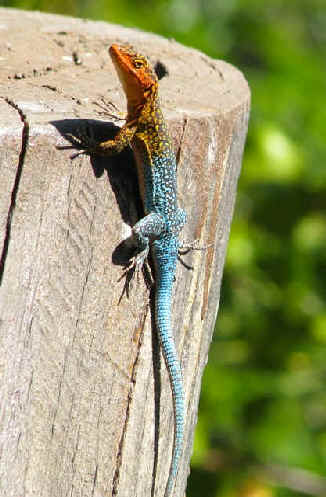
Two photos of the beautiful Thin Tree
Lizard,
during the FONT Chile Tour in November 2011,
both actually of the same creature, even though
the hues of the coloration appear different.
(photos by Frank Stermitz)
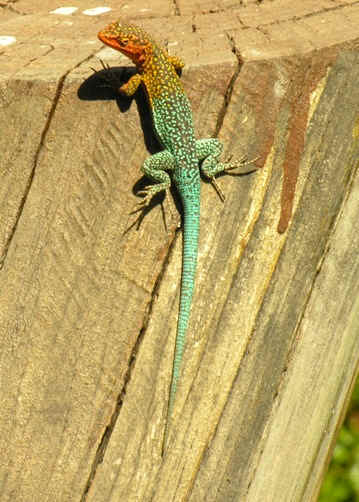
- Zapallar Lizard (CHv) ______ CH
(WGC:111)
CH common name: Lagarto de Zapallar
Liolaemus zapallarensis
Endemic to Chile, LIolaemus zapallarensis occurs from Coquimbo to
Valparaiso, from sea level to 1,650 feet.
- Liolaemus zabalai ______
CH
A newly-described species, in
2015, at the Laja Lagoon in the Bio-Bio province of Chile.
Subfamily TROPIDURINAE: Pacific Iguanids
- Atacama Lava Lizard ______ CH
(WGC:115)
CH common name: Corredor de Atacama
Microlophus atacamensis
Endemic to Chile, Microlophus atacamensis is common on dark coastal rocks
by the Pacific in the Atacama Desert.
Microlophus atacamensis and Microlophus tatapacensis are
similar in appearance.
- Desert Lizard ______ CH
CH common name: Corredor de Tarapaca
Microlophus tarapacensis
Microlophus tarapacensis
occurs in tamarugo groves in Tarapaca in northern Chile.
- Four-banded Pacific Iguana
______ CH
Microlophus quadrivittatus
Endemic to Chile, Microlophus quadrivittatus
occurs in Arica in northern
Chile.
- Microlophus yanezi ______
CH
Endemic to Chile, Microlophus yanezi
occurs in Arica in the far-northern part of the country.
- CH common names: Corredor de Pica
(or Corredor de Tereza)
______ CH
(WGC:115)
Microlophus theresioides
Endemic to Chile, Microlophus theresioides
occurs in desert in the area of Pica in Tararpaca in northern
Chile.
- CH common name: Corredor de Arica ______ CH
Tropidurus heterolepis
Tropidurus heterolepis feeds on invertibrates and algae along the
Arica coast in northern Chile.
Subfamily TROPIDURINAE: Dragon Lizards
- CH common name: Lagarto Dragon de Reiche ______
CH (WGC:115)
Phrynosaura reichei
In northern Chile, Phrynosaura reichei occurs from Arica to
Antofagasta, where it is rare.
- CH common name: Lagarto Dragon de Oido Cubierto
______ CH
Phrynosaura audituvelata
In northern Chile, Phrynosaura audituvelata occurs from Arica to
Tarapaca, where it is rare.
- CH common name:
Lagarto Dragon ______ CH
(WGC:115)
Phrynosaura
manueli
Endemic to Chile, Phrynosaura manueli
occurs in northern Chile at Diego de Alamgro, in Atacama, where it is
rare.
-
Phrynosauta torresi ______ CH
Endemic to Chile, Phynosaura torresi
occurs only at Calama.
Subfamily TROPIDURINAE: Mountain Lizards
- High Mountain Lizard (t) ______
AR CH (WGC:115)
CH common name: Matuasto
Phymaturus flagellifer
In Chile, Phymaturus flagellifer occurs from Santiago to Maule.
It is also in adjacent Argentina.
The species occurs from 1,950 to 11,500 feet above sea
level.
-
Phymaturus vociferator ______ CH
Phymaturus vociferator occurs in Chile in the High Andes of
Biobio, where it is rare. It makes loud noises when disturbed.
Subfamily TROPIDURINAE: Patagonian Lizards
- Leopard Grumbler ______ CH
(WGC:115)
Diplolaemus leopardinus
In Chile, Diplolaemus leopardinus occurs locally in the Lonquimay
Valley in Araucania from 3,500 to 6,500 feet above sea level.
- Darwin's Grumbler ______ CH
(WGC:115)
Diplolaemus darwinii
In Chile, Diplolaemus darwinii occurs in Magallanes from sea
level to 1,300 feet.
- Bibron's Grumbler ______ CH
Diplolaemus bibronii
In Chile, Diplodaemus bibronii occurs from Aisen to Magallanes,
from sea level to 3,500 feet.
Subfamily POLYCRINAE: Primitive Anoles
- Southern Grumbler
(or Forest Lizard) (*) ______
CH (WGC:115)
CH common name: Grunidor del Sur
Prisitidactylus torquatus
Endemic to Chile, Prisitidactylus torquatus occurs from Maule to Los
Lagos, in open woodland and matorral.
- Prisitidactylus
valeriae (CHr)
______ CH
Endemic to Chile, Prisitidactylus valeriae occurs locally at Altos de
Cantillana in Valparaiso.
- Prisitidactylus
alvaroi (CHr) ______ CH
Endemic to Chile, Prisitidactylus alvaroi occurs locally at Cerro El
Roble in Santiago.
- Prisitidactylus
volcanensis (CHr) ______ CH
(WGC:115)
Endemic to Chile, Prisitidactylus volcanensis occurs at El Volcan in the
Andes near Santiago.
Family TEIIDAE: Whiptails and Tegus
- Chilean Iguana (CHv) (*) ______ CH
(WGC:115)
CH common name: Iguana Chilena
Callopistes maculatus (palluma)
Endemic to Chile, Callopistes maculatus occurs from Antofagasta to
Maule.
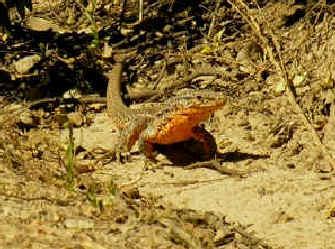
Two photographs of a Chilean Iguana, during the
FONT Chile Tour in November 2011.
In the lower photo, the lizard is slithering on its way.
(photos by Frank Stermitz)
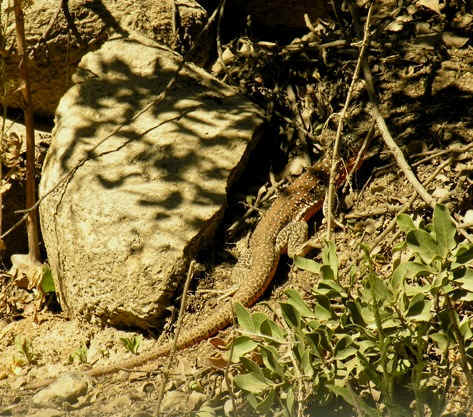
Family GECKONIDAE: Geckos
- Chilean Marked Gecko ______ CH
(WGC:116)
CH common name: Salamanqueja del Norte Chico
Homonota gaudichaudii
In Chile, Homonota gaudichaudii occurs from Antofagasta to
Coquimbo, where it is found along the desert coast, often near Copao cactus.
The species also occurs in nearby Bolivia.
- Darwin's Marked Gecko ______ CH
Homonota darwinii
In Chile, Homonota darwinii occurs in Patagonia.
- D'Órbigny's Marked Gecko
______ CH
Homonota dorbignii
In Chile, Homonota dorbignii occurs from Aconcagua to Valparaiso,
where it is mainly coastal.
- Coquimbo Marked Gecko ______ CH
Homonota penai
Endemic to Chile, Homonota penai occurs from Atacama to Coquimbo, in the
interior desert.
- Leaf-toed Gecko ______ CH
(WGC:116)
CH common name: Salamanqueja del Norte Grande
Phyllodactylus gerrhopygus
In Chile, Phyllodactylus gerrhopygus occurs from Arica to
Antofagasta.
- Phyllodactylus heterurus ______
CH
Phyllodactylus heterurus
is endemic to Chile.
- Peru Leaf-toed Gecko
______ CH
Phyllodactylus inaequalis
In Chile, Phyllodactylus inaequalis occurs locally at the Mamina
Oasis inland from Iquique on the Antofagasta coast. It also occurs in
western Peru.
Snakes
Suborder SERPENTES
Family COLUBRIDAE: Colubrid Snakes
- Long-tailed Green Racer (CHv) ______ CH
(WGC:117) (also called Chilean Long-tailed Snake)
CH common name: Culebra de Cola Larga
Philodryas chamissonis
Philodryas chamissonis
is endemic to Chile, occurring from Atacama to Biobio in coastal desert
and the Mediterranean zone.
- Elegant Racer (CHv) ______ CH
(WGC:117)
Philodryas
(formerly Alsophis)
elegans
In Chile, Philodryas elegans occurs locally in the coastal and
inland desert of Tarapaca, from sea level to 10,000 feet.
- Schmidt's Racer (CHv) ______ CH
Philodryas tachimenoides
In Chile, Philodryas tachimenoides occurs locally in Arica
in Camarones, Lluta, and Azapa Quebradas.
- Simon's Racer ______ CH
Philodryas simonsii
In Chile, Philodryas simonsii occurs in Arica.
- Chilean Slender Snake (CHv) ______ CH
(WGC:117)
CH common name: Culebra de Cola Corta
Tachymenis chilensis
In Chile, Tachymenis chilensis occurs from Atacama to Los Lagos. The
species is venomous. It also occurs in Peru.
- Peru Slender Snake ______ AR
CH
Tachymenis peruviana
In Chile, Tachymenis peruviana occurs in the High Andes of Arica
and Tarapaca. It also occurs in Peru, Bolivia, and in northwest Argentina.
Family HYDROPHIIDAE: Sea Snakes
- Yellow-bellied Sea Snake ______ CH
(WGC:117)
Pelamis platurus
Pelamis platurus
is widespread in the Indo-Pacific Ocean.
To Top of
Page


 Amphibians
Amphibians
![]()




